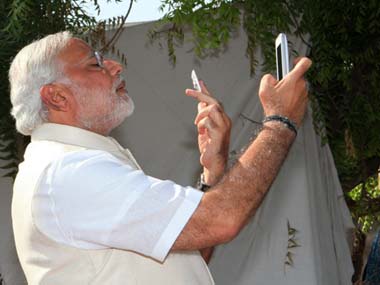As India embraces the global selfie culture, it’s time to sit down and think of the implications of this phenomenon. The first point is, for the foreseeable future, it will stay one, thanks to the ubiquity of the camera. Every phone today has one – and everyone, well, nearly everyone, has a phone. [caption id=“attachment_1518939” align=“alignleft” width=“380”]
 Narendra Modi took a selfie after he voted in Baroda. AFP[/caption] The selfie momentum surged thanks to the Ellen Degeneres Oscar selfie – which caused
twitter to crash
and broke
Barack Obama’s RT record
. The momentum continued with the ‘fingie’ – the selfie of the finger tainted with ink to prove that you had voted – and the Narendra Modi selfie post his casting his vote made selfies the coolest thing ever. So, without a doubt, we’ll see selfies flooding our social media timelines. Which brings me to the point of the post. Because the selfie is taken by ‘self’, it is always a close up, as the phone cannot be more than an arm’s length away. And a close-up presents a new set of issues. Since this is a close-up of a face, we get close-up views of the hair, the eyes, the nose, the ears and, of course, the smile. How are your teeth (which we will see if you smile)? Are they clean? Are they white? Are there food particles stuck in between teeth? Or is your selfie doomed to be one that shows no teeth? Is your hair neatly combed/brushed? Is your moustache trimmed? The situation gets worse when it is not a single selfie, but a couple or group selfie. While these problems do not affect the selfie, they affect the live situation. Do you have bad breath? Have you used deodorant? After shave? Perfume? It’s something so small and insignificant – but the implications are enormous and far-reaching. For example, according to an expert, selfies have lead to an outbreak of, believe it or not,
head lice cases
. So we start asking new questions about personal hygiene and selfies as well. So something as seemingly innocuous as selfies are opportunities for a wide range of products and professions. Toothpaste, floss, mouth wash, perfume, after shave, razors, make-up, deodorant, hair gel, shampoo, hairddressers, dentists, opticians… the list is excitingly endless. And the list all began with a mobile device with a camera.
Narendra Modi took a selfie after he voted in Baroda. AFP[/caption] The selfie momentum surged thanks to the Ellen Degeneres Oscar selfie – which caused
twitter to crash
and broke
Barack Obama’s RT record
. The momentum continued with the ‘fingie’ – the selfie of the finger tainted with ink to prove that you had voted – and the Narendra Modi selfie post his casting his vote made selfies the coolest thing ever. So, without a doubt, we’ll see selfies flooding our social media timelines. Which brings me to the point of the post. Because the selfie is taken by ‘self’, it is always a close up, as the phone cannot be more than an arm’s length away. And a close-up presents a new set of issues. Since this is a close-up of a face, we get close-up views of the hair, the eyes, the nose, the ears and, of course, the smile. How are your teeth (which we will see if you smile)? Are they clean? Are they white? Are there food particles stuck in between teeth? Or is your selfie doomed to be one that shows no teeth? Is your hair neatly combed/brushed? Is your moustache trimmed? The situation gets worse when it is not a single selfie, but a couple or group selfie. While these problems do not affect the selfie, they affect the live situation. Do you have bad breath? Have you used deodorant? After shave? Perfume? It’s something so small and insignificant – but the implications are enormous and far-reaching. For example, according to an expert, selfies have lead to an outbreak of, believe it or not,
head lice cases
. So we start asking new questions about personal hygiene and selfies as well. So something as seemingly innocuous as selfies are opportunities for a wide range of products and professions. Toothpaste, floss, mouth wash, perfume, after shave, razors, make-up, deodorant, hair gel, shampoo, hairddressers, dentists, opticians… the list is excitingly endless. And the list all began with a mobile device with a camera.
Anant Rangaswami was, until recently, the editor of Campaign India magazine, of which Anant was also the founding editor. Campaign India is now arguably India's most respected publication in the advertising and media space. Anant has over 20 years experience in media and advertising. He began in Madras, for STAR TV, moving on as Regional Manager, South for Sony’s SET and finally as Chief Manager at BCCL’s Times Television and Times FM. He then moved to advertising, rising to the post of Associate Vice President at TBWA India. Anant then made the leap into journalism, taking over as editor of what is now Campaign India's competitive publication, Impact. Anant teaches regularly and is a prolific blogger and author of Watching from the sidelines.
)